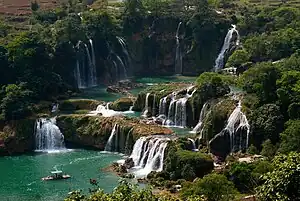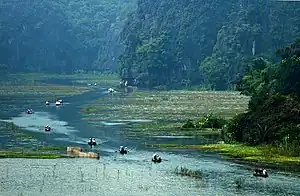Northern Vietnam


Northern Vietnam is the cradle of the Vietnamese civilization and hence, home to more historical and cultural attractions than other regions. Its shoreline and mountains also offer impressive landscapes. Its most popular destinations, Hanoi, Ha Long Bay, Ninh Binh and Sa Pa, are also among the most visited in Vietnam.
Cities
Other destinations
- 🌍 Ha Long Bay – Popular with the islands of Van Don, Cat Ba, Quan Lạn
- 🌍 Ba Be National Park – Scenic mountains and lakes
- 🌍 Bac Ha – With hilltribe markets near the Chinese border
- 🌍 Bắc Kạn – A place of the beautiful Ba Bể Lake, meaning three combined lakes.
- 🌍 Co To Island
- 🌍 Cuc Phuong National Park
- 🌍 Dien Bien Phu – The site of the French defeat in 1954
- 🌍 Dong Dang – On the border with China
- Dong Van – Dong Van Karst Plateau Geopark
- 🌍 Bai Tu Long Bay
- 🌍 Sa Pa – A popular site for visiting indigenous tribes
- 🌍 Tuan Chau Island
Understand
There are quite considerable differences between the mountainous and delta areas in Northern Vietnam. The mountainous provinces bordering China have dramatic landscape, such as pristine subtropical forests, rice terraces and tea plantations. These provinces are less developed, with fewer industries and more ethnic groups. Notable tourist attractions are Ha Giang and Sa Pa.
The lowland and delta areas were traditionally farming areas, but the pronvinces around Hanoi (Bac Ninh, Thai Nguyen, Vinh Phuc, Hung Yen, and Hai Duong) are now largely industrialized. Toward the South China Sea are Ha Long Bay with hundreds of limestone karsts and caves, and Hai Phong, a major port and the third largest city in Vietnam.
Get in
By plane
- 🌍 Cat Bi International Airport (HPH IATA) near Hai Phong — has a few international connections
- 🌍 Điện Biên Phủ Airport (DIN IATA) near Dien Bien Phu
- 🌍 Noi Bai International Airport (HAN IATA) near Hanoi — has international connections all over the world
- 🌍 Van Don International Airport (VDO IATA) near Cai Rong
Get around
There are of course lots of buses available in the region.
Many travellers prefer to do the Ha Giang Loop by motorbike: 🌍 Ha Giang – 🌍 Yen Minh – 🌍 Dong Van – 🌍 Du Gia – Ha Giang.
See
Do
Cycling is a niche but growing activity in Northern Vietnam, progressively getting more challenging the farther you venture out of Hanoi. During your ride, you will be distracted by dense jungle, misty hills and mountains and gorgeous rice terraces. But to explore the region to its fullest, you ought to be an experienced peddler. If you are skilled and brave enough, make sure to ride along the jaw-dropping Mã Pí Lèng Pass between the towns of Dong Van and Meo Vac.
At the end of a busy day hiking or cycling, its worth trying a herbal bath (tắm lá thuốc) - an ancient tradition of some ethnic minorities and particularly the Red Dao people. Many massage parlours in towns across the region have these baths. Some appear to be appropriating this cultural practice, but some are very traditional, with families or groups having their own recipes of dozens (or up to hundreds) of herbal ingredients than are dried, then boiled until the water is fragrant, and a deep red or green colour. A 30 minute dip in one of these baths will have you feeling very relaxed.
Buy
Most local markets in the north of Vietnam take place on a particular day each week. For example, Dong Van Market and Can Cau Markets take place on Saturday or Sunday. The markets open at 05:00 and close at 15:00-16:00. Ethnic peoples, such as the Hmong, Dzao, Tay, Lo Lo and Tu Di, go to the market from the early morning on by foot, horse and motorbike. They travel in families and groups of young girls and boys in their most colorful clothes. Even if don't sell all of their products, they still meet their old friends and have a chance to drink, chat or share their life stories. Some other markets are exceptional: They are “backward markets”! They take place every 6 days, calculated by the Lunar Calendar.
Eat
Drink
Stay safe
In the northern part of Vietnam the dangers are small. Just like every other country there are pickpockets and a few scammers, but this is your biggest worry from the locals.
If you visit the wild nature next to the Chinese border, not many animals are dangerous. But a few wild cats are seen now and then in the nature reserves, like the Asian golden cat.
Go next
- Vietnam's Central Coast to the south